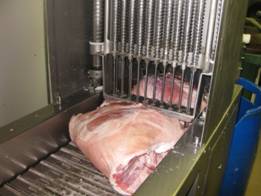Bacon
There are different types of bacon in different parts of the world with some variations occurring throughout the manufacturing process and hence in the final product. Salt has been reduced through the years, and most 'modern' bacons have lower salt than the traditional ones. However, not much research work has been reported publicly. Similarly, the production process has been modified; for example, 'modern' bacons are produced relatively quickly compared with traditional dry-curing or Wiltshire-style bacon (which requires several weeks to achieve stability in the product). The main approaches that have been used to reduce processing time are:
- the use of smaller, boneless pieces
- applying multi-needle injectors instead of tank curing
- tempering prior to high-speed slicing.
Here is an example of how the procedure that is used can have an effect on the physical and organoleptic characteristics as well as the final salt content. Salt content, however, was reasonably high in all types.
Figure 4.2 Multi-needle injection

Here is an example of how the procedure that is used can have an effect on the physical and organoleptic characteristics as well as the final salt content. Salt content, however, was reasonably high in all types.
- Effects of bacon type, injection level, salt concentration, maturation time and tempering
Using the same salt concentration for brines in Wiltshire and rapid-cured bacons, and a similar concentration (not specified) in dry cured bacon, the main results were as follows:
- The mean salt content in the final product was 3.1% for Wiltshire, 3.8% for rapid-cured and 2.7% for dry-cured bacon.
- Wiltshire-cured bacon had the lowest weight losses.
- Bacons with higher injection levels lost more moisture during maturation; however, injected salt appeared to have been retained, suggesting that moisture lost was largely by evaporation.
- Moisture content was highest in rapid-cure bacon which was held in vacuum packs during maturation, giving little chance for water to evaporate (Sheard et al., 2000).